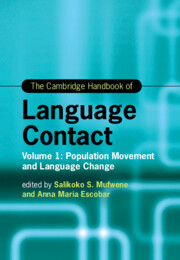Book contents
- The Cambridge Handbook of Language Contact
- Cambridge Handbooks in Language and Linguistics
- The Cambridge Handbook of Language Contact
- Copyright page
- Contents
- Maps Volume I
- Figures Volume I
- Tables Volume I
- Contributors
- Preface
- Introduction
- Part One Language Contact and Genetic Linguistics
- Part Two Linguistic Areas
- Part Three Language Spread
- Part Four Emergence and Spread of Some European Languages
- Part Five Language Diasporas
- 19 Diasporas: An Overview
- 20 Labor Migrations: Language Change in Communities and Diasporas
- 21 The Korean Diaspora
- 22 The Chinese Diaspora: Language Maintenance and Loss
- 23 The Diachrony of Yiddish and Judaeo-Spanish as Contact Languages
- Author Index
- Language Index
- Subject Index
- References
22 - The Chinese Diaspora: Language Maintenance and Loss
from Part Five - Language Diasporas
Published online by Cambridge University Press: 02 June 2022
- The Cambridge Handbook of Language Contact
- Cambridge Handbooks in Language and Linguistics
- The Cambridge Handbook of Language Contact
- Copyright page
- Contents
- Maps Volume I
- Figures Volume I
- Tables Volume I
- Contributors
- Preface
- Introduction
- Part One Language Contact and Genetic Linguistics
- Part Two Linguistic Areas
- Part Three Language Spread
- Part Four Emergence and Spread of Some European Languages
- Part Five Language Diasporas
- 19 Diasporas: An Overview
- 20 Labor Migrations: Language Change in Communities and Diasporas
- 21 The Korean Diaspora
- 22 The Chinese Diaspora: Language Maintenance and Loss
- 23 The Diachrony of Yiddish and Judaeo-Spanish as Contact Languages
- Author Index
- Language Index
- Subject Index
- References
Summary
The Chinese diaspora comprises sizeable ethnic Chinese populations spread across the globe. Although Chinese diasporic communities share a common heritage and, by definition, a common heritage language, their sociolinguistic backgrounds and identities are diverse, complex, and multifaceted. Members of the diaspora speak one or more, or indeed none, of several mutually unintelligible Chinese varieties and dialects. Recent changes in the demographics of the overseas Chinese communities have, moreover, led to new patterns of multilingualism. This chapter discusses key sociolinguistic aspects of language contact relevant to this group at large, including language maintenance versus language loss, the trends and challenges of heritage language learning, the role of Chinese community schools, differences in attitudes towards Chinese dialects, and the dynamics of multilingual identities and multilingual practices such as translanguaging and language brokering. The review focuses on the diasporic communities in Anglophone and other Western settings, as it is mainly the rising numbers of ethnic Chinese in those parts of the world that have fuelled the growing interest in Chinese heritage language learning and research in recent decades.
Keywords
- Type
- Chapter
- Information
- The Cambridge Handbook of Language ContactVolume 1: Population Movement and Language Change, pp. 690 - 715Publisher: Cambridge University PressPrint publication year: 2022

